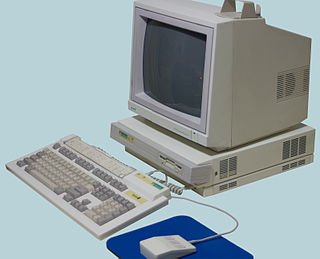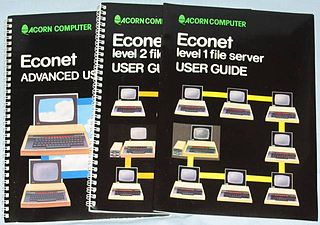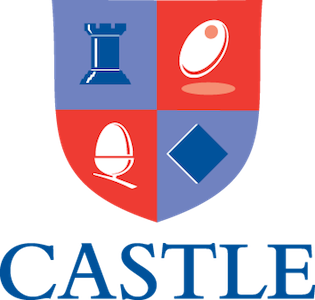Related Research Articles
BBC BASIC is an interpreted version of the BASIC programming language. It was developed by Acorn Computers Ltd when they were selected by the BBC to supply the computer for their BBC Literacy Project in 1981.

Acorn Computers Ltd. was a British computer company established in Cambridge, England in 1978 by Hermann Hauser, Chris Curry and Andy Hopper. The company produced a number of computers during the 1980s with associated software that were highly popular in the domestic market, and they have been historically influential in the development of computer technology like processors.

Risc PC was a range of personal computers launched in 1994 by Acorn, replacing the Archimedes series. The machines use the Acorn developed ARM CPU and were thereby not IBM PC-compatible.

The Acorn Archimedes is a family of personal computers designed by Acorn Computers of Cambridge, England. The systems in this family use Acorn's own ARM architecture processors and initially ran the Arthur operating system, with later models introducing RISC OS and, in a separate workstation range, RISC iX. The first Archimedes models were introduced in 1987, and systems in the Archimedes family were sold until the mid-1990s alongside Acorn's newer Risc PC and A7000 models.

RISC OS is an operating system designed to run on ARM computers. Originally designed in 1987 by Acorn Computers of England, it was made for use in its new line of ARM-based Archimedes personal computers and was then shipped with other computers produced by the company. Despite the demise of Acorn, RISC OS continues to be developed today by the RISC OS Open community on version 5.0 of the system that was open sourced in 2018.
ARX was an unreleased Mach-like operating system written in Modula-2+ developed by Acorn Computers Ltd in the Acorn Research Centre (ARC) United Kingdom (UK) and later by Olivetti—which purchased Acorn—for Acorn's new Archimedes personal computers based on the ARM architecture reduced instruction set computer (RISC) central processing unit (CPUs).

Econet was Acorn Computers's low-cost local area network system, based on a CSMA-CD serial protocol carried over a five-wire data bus, intended for use by schools and small businesses. It was widely used in those areas, and was supported by a large number of different computer and server systems produced both by Acorn and by other companies.
Timeworks Publisher was a desktop publishing (DTP) program produced by GST Software in the United Kingdom and published by Timeworks, Inc., in the United States.
Xara is an international software company founded in 1981, with an HQ in Berlin and development office in Hemel Hempstead, UK. It has developed software for a variety of computer platforms, in chronological order: the Acorn Atom, BBC Micro, Z88, Atari ST, Acorn Archimedes, Microsoft Windows, Linux, and more recently web browser-based services.

Castle Technology Limited, named after Framlingham Castle, was a British computer company based in Cambridge, England. It began as a producer of ARM computers and manufactured the Acorn-branded range of desktop computers that run RISC OS.
The Fourth Dimension (4D) was a major video game publisher for the BBC Micro, Acorn Electron, Acorn Archimedes and RiscPC between 1989 and 1998. Previously, The Fourth Dimension had been known as Impact Software, which specialised mainly in BBC Micro games. Some of 4D's staff had worked for Superior Software. Notable release included Cyber Chess, Stunt Racer 2000, Galactic Dan and Chocks Away.

The Machine Operating System (MOS) or OS is a discontinued computer operating system (OS) used in Acorn Computers' BBC computer range. It included support for four-channel sound, graphics, file system abstraction, and digital and analogue input/output (I/O) including a daisy-chained expansion bus. The system was single-tasking, monolithic and non-reentrant.

Acorn User magazine was founded by Acorn Computers in 1982, contract-published by Addison-Wesley, to coincide with the launch of the BBC Micro. It covered the range of Acorn home computers, the BBC Micro and Atom at first and later the Electron, Archimedes and Risc PC.

Paper models, also called card models or papercraft, are models constructed mainly from sheets of heavy paper, paperboard, card stock, or foam.

The BBC Microcomputer System, or BBC Micro, is a series of microcomputers designed and built by Acorn Computers Limited in the 1980s for the Computer Literacy Project of the BBC. The machine was the focus of a number of educational BBC TV programmes on computer literacy, starting with The Computer Programme in 1982, followed by Making the Most of the Micro, Computers in Control in 1983, and finally Micro Live in 1985.
NCOS is the graphical user interface-based operating system developed for use in Oracle Corporation's Network Computers, which are discontinued. It was adapted by Acorn Computers from its own RISC OS, which was originally developed for their range of Archimedes desktop computers. It shares with RISC OS the same 4 MB ROM size and suitability for use with TV displays.
RISC OS, the computer operating system developed by Acorn Computers for their ARM-based Acorn Archimedes range, was originally released in 1987 as Arthur 0.20, and soon followed by Arthur 0.30, and Arthur 1.20. The next version, Arthur 2, became RISC OS 2 and was completed and made available in April 1989. RISC OS 3 was released with the very earliest version of the A5000 in 1991 and contained a series of new features. By 1996 RISC OS had been shipped on over 500,000 systems.
Gordon J. Key authored video game software for the Acorn BBC Micro, Electron and RISC OS platforms in the 1980s and 1990s. His most well-known works were published by The Fourth Dimension. He is also credited with additional programming routines in FedNet's futuristic flight combat game Star Fighter 3000 (1994), and authored Party Machine for the Amstrad CPC.
In computing, Philip's Music Writer or PMW, formerly known as Philip's Music Scribe or PMS, is a music scorewriter written by Philip Hazel. It was mentioned in the Center for Computer Assisted Research in the Humanities publication Computing in Musicology in 1993 and remains under active development as free software.
Impression is a desktop publishing application for RISC OS systems. It was developed by Computer Concepts and initially made available in pre-release form during 1989, having been demonstrated in February 1989 at the Which? Computer Show and subsequently announced as being available from June 1989. The "completed" version was eventually delivered on 18th January 1990.
References
- ↑ "Education, Be king of the castle". Acorn User. No. 76. Redwood Publishing. November 1988. p. 15. ISSN 0263-7456.
- 1 2 3 4 Drage, Chris (September 1991). "Design for learning". BBC Acorn User. No. 110. Redwood Publishing. pp. 110–111. ISSN 0263-7456.
- 1 2 Drage, Chris; Evans, Nick (March 1989). "Cut out and keep". BBC Acorn User. No. 80. Redwood Publishing. pp. 90–91. ISSN 0263-7456.
- ↑ "Who´ll come out top in our schools?". The Guardian. London: Guardian and Manchester Evening News Ltd. 25 January 1990. p. 31. ISSN 0261-3077.
- ↑ Drage, Chris (February 1991). "Across the board". BBC Acorn User. No. 103. Redwood Publishing. p. 79. ISSN 0263-7456.
- ↑ Brown, Andrew (3 February 1990). "Your format, BBC, Fear and shivers". New Computer Express. No. 65. Future Publishing. p. 15. ISSN 0957-0640.
- ↑ "Archived copy". Archived from the original on 2020-08-19. Retrieved 2021-02-26.
{{cite web}}: CS1 maint: archived copy as title (link)